Ferrari at Indianapolis: mutual love unanswered
1971-1973: 'Meet my uncle Franco'
Author
- Henri Greuter
Date
- February 21, 2013; Mario Andretti interview added on June 18, 2020
Related articles
- March-Porsche 90P - The last oddball at the Indianapolis Motor Speedway, by Henri Greuter
- March-Alfa Romeo 90CA - Fiasco Italo-Brittanico, by Henri Greuter
- The Race of Two Worlds - The 1958 "Monzanapolis" bash, by Darren Galpin
- Ferrari at Indianapolis, by Henri Greuter
- 1951: Ferrari and Indianapolis
- 1952: Ferrari at Indianapolis
- 1956: A 'hybrid' against one of Indy's most persistent jinxes
- 1958: At home against Indycars
- 1961-1968: of phantoms and enfants terribles
- 1975: A loud insect never leaving the chrysalis as was intended and hoped for…
- Intermezzo: Ferrari and turbocharging
- 1986: Projects 034 and 637, mere blackmail tools?
- 2000-2007: It's Indy, Gino, but not as we know it
- Appendix: The cars
Who?1973 Offenhauser (in Gordon Johncock's original 1973 Indy 500-winning Eagle-Offy) What?The most powerful race-winning engine in Indy 500 history Where?IMS Museum When?May 12, 2011 |
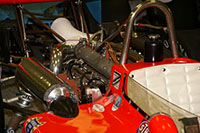 |
Why?
Very little is known of what appears to be Ferrari's next Indy plan. This involved Mario Andretti, as Peter Windsor mentioned on his blog in early 2012. Windsor tells how Mario related this to him during dinner sometime late 1978. According to Mario, Ferrari planned to go to Indy in 1973. Sometime earlier Mario played to host to Franco Rocchi, a leading Ferrari engine man, showing him the way around and introducing him as a family member: his 'uncle Franco' who owned a small workshop in Italy and was a fan of engines. Rocchi was supposed to obtain first-hand information from the engines that were used at the time at Indy. Initially the cover held up and Rocchi was welcome with just about anyone. The trick might have worked if it wasn't for the fact that Rocchi was recognized by a McLaren mechanic who had seen Rocchi when they both had been part of Chris Amon's Tasman Series team. Fortunately for Rocchi, McLaren was one of last teams he visited and he pretty much had already found out what he wanted to know. More crucially, the element of surprise was gone, which seems to have been the major reason to give up on the plan.
In his blog, Windsor doesn't mention the year this supposedly took place. The FerrariStory magazine, however, published an article about Ferrari's Indy exploits in their 1996 edition. It mentions a story with similar details and says it took place in 1971 but eventually ended up in nothing.
You can have moments in life when you found out that, many years ago, you were given a gold nugget but failed to recognize it as such and passed on what could have been a great scoop. In June 2020, I discovered I had such a moment at Indianapolis in May 1989, sometime in between Bump Day (May 21) and May 26.
I had the pleasure of having an extended talk with Mario Andretti. At that time I was working on something entirely different so the focus of discussion was on topics related to that project. In June 2020, while preserving the tape of that interview, I found that I had missed out on a big secret. We had talked briefly about the '67 Turbine car and the rumour I had heard about Mario possibly being involved in plans of a side-by-side chassis fitted with a Ferrari V12 for the 1968 race. Mario dismissed this rumour, as in 1968 he was not involved with Granatelli and/or STP yet, and we concluded that this story was likely a case of my source messing up the years. The name of Lotus was dropped as well because of their building cars for the STP team that year.
But then Mario said something that at the time went unnoticed to me and that I never gave the attention it should have deserved. What Mario said was this:
"Ferrari was always, they were ever interested. In fact I had Ferrari almost coming here in 1972, but they were interested in doing the engine and chassis, not just engines. They were not interested in collaborating with Lotus because Lotus was a competitor."
As I said, I had other topics to focus on, so even if I had noticed the significance of this comment I doubt whether I would have given this comment the follow-up discussion it would have needed when I wrote the original version of this article in late 2012 and early 2013. And thus, it had to be written with information available elsewhere at that time.
One could discard projects that never came to fruition as being of no relevance and little importance. However, as the 1961 and 1968 parts of this story already proved, diving deeper into the matter and looking closer into the situation at Ferrari as well as at Indy at the time, this project becomes much more interesting. First of all, let's have a look at what Franco Rocchi got to see in 1971.
The two most important engines of that year were the turbocharged Offy four-cylinder and the turbocharged version of the former Ford Quadcam V8. Ford had ended its involvement with the engine after the 1970 race, an event they had won. The hardware was turned over to AJ Foyt and his engine man Howard Gilbert. They took up the challenge of keeping the engine competitive. In 1971 this was indeed beginning to become a challenge, as the advantage which had been with the Ford began to shift to the Offy since the old fourbanger (whose origins were founded in 1932, its basic concepts going back to 1912!) was perhaps old-fashioned but very durable. Originally a long-stroke atmospheric engine, it was initially a 4.5-litre in the post-war years. From 1957 on it was reduced to 4.2 litre. Forced by opposition from Ford in the mid-sixties the old fourbanger had been developed into an oversquare 2.65-litre blown version. The Offy becoming oversquare must have been sacrilege to a number of Offy adepts. There is no doubt that this development into a blown Offy was the largest and most dramatic upgrade during the engine's long career.
Meyer & Drake Engineering, the long-time builders of the Offy, stopped existing under that name when Lou Meyer sold out to his partner Dale Drake and hedged his bets on becoming involved with development and marketing for the Ford V8 engine. So it was Drake Engineering that took up the challenge and came with a 2.8-litre Offy engine suitable for being either Roots-blown or turbocharged, the turbocharged option eventually becoming the most suitable option. The turbo Offy literally blew new life into the old Offy and also blew the Ford away. We already mentioned how 1968 was the year that turbo-Offy was about to run over the Ford V8. The atmo Ford engine still remained well-suited to Championship dirt track racing. Then, during 1968, a turbocharged version of the Ford was developed as well and this eventually gained back the edge over the Offies. Because of its competition Ford and Offy were forced to work on ever increasing levels of turbo boost in order to generate more power.
For reasons we won't go into here, the capacity of blown engines was reduced from 2.8 litre to 2.65 litre from 1969 on. In 1971 the advantage slowly shifted back to the Offy. In his excellent publication Design & Development of the Indycar author Roger Huntington states that the Foyt-maintained Ford was less capable than the Offies of withstanding the ever-increasing boost levels could, some 850 to 900hp being the maximum output for the V8. Discussions on various Internet forums as well as personal correspondence, however, learned that in the very early seventies it was possible to obtain 1000-1100hp or more from the Ford V8, as long as you dared turn up the boost. Using a high percentage of nitromethane-containing fuel blends also helped keep the engine in one piece. These outputs were on par with what the Offy was capable of. Nevertheless, a shift towards the use of Offy engines (and more success gained by Offy engines) is notable. Even teams having these 1000+ hp Fords switched to Offies. It's not easy to find a definitive cause for this change. The best explanation I can think of is that according to reports AJ Foyt did little in creating new parts to keep his engines running, and that for just about anyone else but Foyt himself it became increasingly difficult to keep their Fords running. Besides that, there was the suspicion that of the engines he built Foyt made sure that he kept the best ones for himself.
With more prominent teams 'driven' towards the Offy's corner, it also meant that more engineers got involved with extracting more power out of the old fourbanger. In 1971, the Offy could be rated at about 750hp, perhaps more in qualifying. How much more boost the Offy could take was a matter of trial and error for an increasing number of engine wizards. These experiments were pay off in big, big numbers.
Ferrari intended to be at Indy in 1973, If they had made it they would have been up against a truly formidable opponent since 1973 was perhaps the hallmark year for the Offy engine if it came to all-out raw performance. In 1973 there were Offies that withstood about 3 atm of boost and produced close to 1200hp. The real figures for boost and power output were perhaps even higher since the teams were very secretive about what they achieved. The highest published values I ever found were in Mark Dees' Miller Dynasty in which he said that a Dan Gurney-prepared Offy on a test bench produced an unintended 1430hp after the engine accidentally ran with a blocked boost control system, causing the boost to have gone sky high.
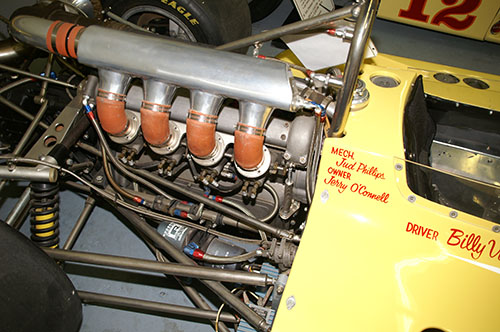
A close up of a 1973-spec Offy, photographed in the car that finished second in the 1973 race. Perhaps the Offy was old-fashioned and outdated, but it was capable of staggering performances, showing that simplicity had its merits. (photo HG)
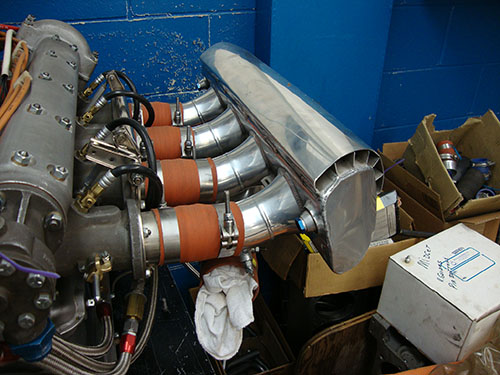
The rules stated that intercooling was forbidden but as this picture proves you could still achieve something of an intercooling effect when the inlet plenum was out in the airstream. Clever yet legal.
(photo courtesy Aaron Lewis, used with permission)
F1 fans unimpressed with these figures will perhaps compare these with the rumoured 1400+ hp on over 5atm of boost for BMW's 1986 1.5-litre F1 engine. But for starters, intercoolers weren't allowed in 1973 and highly advanced management systems didn't exist yet. Now imagine if these devices had these been fitted to a 1973 Offy. The Offy also lacked the backing and both the technical and financial support of an engine manufacturer and its associates.
Performance-wise 1973 was a hallmark year for the Offy, even though it must be said that it came with a 'but'. The Offy's reliability suffered from these high boost and power output values. In an article published early 2013 Parnelli Jones who during the seventies was a team owner with partner Vel Mitelich stated that the unlimited-boost Offies were pushed beyond their capabilities at the expense of reliability, by then causing several problems. Even with the 1973 race being shortened by rain there were so many retirements due to engine failures that it's interesting to speculate how many cars would have got to the chequered flag if the race had gone the full distance. Approximately one third of the 33 starters were still running when the race ended and some of those many laps down on the leader. Nevertheless, the Turbo Offy's performance was awesome. To put it into perspective: with a third of the number of cylinders and half the capacity it came close to the power output of Porsche's fearsome Can-Am engines.
The 1973 race was one to forget due to accidents (one of them fatal, and practice had seen a fatality already) and it took three days to get the race started due to rain. When rain also ended the race prematurely it was a blessing in disguise. At the end of the day team owner Pat Patrick had one driver who had won the race (Gordon Johncock), one driver who had won the Rookie of the Year award and one driver in hospital in critical condition (Swede Savage). Besides that, Patrick Racing also had a mechanic killed in the pitlane after he was hit by a fire truck running through the pitlane in an attempt to reach the scene of the accident in which Savage had been all but killed. (And he would succumb to the effects of the accident after all, a little more than a month later.)
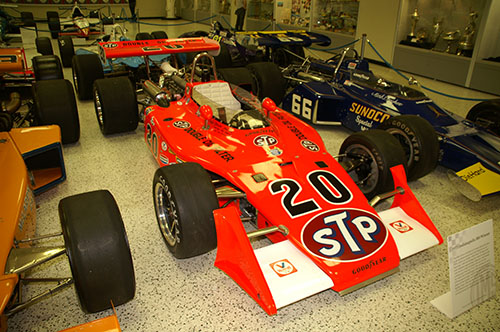
The winning car in 1973 was this Patrick Racing Eagle-Offy driven by Gordon Johncock. It's most likely the most powerful winning car ever to have raced at the Speedway. (photo HG)
Safety demanded that something had to be done to get back to sensible race conditions. And then, after the close of the racing season, the world got into the Arab oil crisis as a result of the Yom Kippur war late 1973. All this combined led to rule changes which saw the turbo boost on Indycar engines limited to 80 inch of mercury, approximately 2.6atm. This was a piece of cake for the Offy to deal with but it reduced power to some 750hp. The Foyt-maintained Ford V8 boasted a bit above 800hp at that level.
These rule changes could not have been anticipated. There was no hint of them during the Month of May in 1973. At that time it looked very likely that the unlimited-boost Offy would be around in 1974 as well.
Now that we know what Ferrari would have been up against in 1973 let's have a look at the situation in Italy after Uncle Franco returned from his holiday.
Knowledge of turbochargers and how to make the most of these devices was limited if available at all at Ferrari. The only experience I am aware of that might be gained in the early seventies in the FIAT group was with some experiments carried out by Lancia with turbocharged versions of the Ferrari Dino V6. These were tried when testing the prototypes of the Lancia Stratos. I however doubt if these experiments already took place in 1971. None of these experiments could be compared with anything done in the USA with the Offies, if it came down to boost levels and power outputs. And if anything, would the knowledge learned by the Lancia engineers about the turbo V6 Dino have trickled down to Ferrari's engineers?
Atmospheric engines didn't stand a chance at Indy anymore so whatever Ferrari intended to use at Indy it had to be turbocharged. But what kind of engine was to be turbocharged?
Rules restricted blown engines to 2650cc, which was reasonably close to the 3-litre limit used in Formula One. So it appears to have been possible to create an engine based on the F1 engines Ferrari was using. At that time Ferrari used its so called Boxer, a flat engine that looked like a boxer engine but in reality was a V12 with a 180-degree V angle. It had failed to win the constructor and driver world titles in 1970 although it had certainly been competitive. According to FerrariStory a 2.65-litre version of this engine was under consideration, although a larger atmospheric version was also considered. Even the dimensions of these 'boxers' were given: the 2.65 litre was reported to have a bore and stroke of 73.8 by 51.5 mm (2643.5cc) while the values for the bigger atmo version were 90 by 58 mm for a reported 4428cc.
These given details, however, create some wonders in particular for the atmo version. Because if the given specifications are indeed correct the engine would be illegal since the maximum allowed capacity for an unblown engine was 4200cc.
By the way, Ferrari could consider themselves lucky they could take up the option of using the boxer. We will never know how close Champ Car and Indy had been to restricting or even banning anything over 8 cylinders if USAC had pursued the threat to penalize such engines in 1968. Luckily it didn't come that far.
Given the success of turbocharged engines at Indy and the number of 4.2 litre atmo engines that qualified in recent races (1968: 11, 1969: 2, 1970 and 1971: none!) as well as the unlocked potential that turbocharging had to offer, the thought of using an atmo version of the 'boxer' appears to be a highly questionable option with little to no potential. With hindsight, no atmospheric engine made it into the starting field of the “500” between 1972 and 1978. The only advantage it had was that in F1 the atmospheric boxer had proven it could be fitted pretty well into a chassis. Because...
... to turbocharge a 2.65 litre version of the 'boxer' and fit this into an open-wheel racer? Have a look at the pictures of the Porsche CanAm engine and now imagine an Indycar around it. The Ferrari engine block was more compact than the large air-cooiled Porsche but you get an idea of the logistics involved in fitting a turbocharged flat-twelve into an open-wheeled racer. Looking at the Indycars built between 1969 and 1970, it's easy to see that some of them were built fairly high at the rear end, especially the ones using Ford V8 engines, be it the 4.2 atmo or the 2.8 turbo. The latter engine in particular had a massive frontal area. A turbocharged 'boxer' could have likely fitted into such a high-shouldered car somehow. But in 1971 a trend started at Indy of building cars with a wider thead front and rear, lowering the cars and reducing its frontal area. The McLaren M16 was the pioneer in this trend. (More on how this trend came about further on.) So could a turbocharged 'boxer' have also fitted easily into the kind of cars that came into existence from 1972 on?
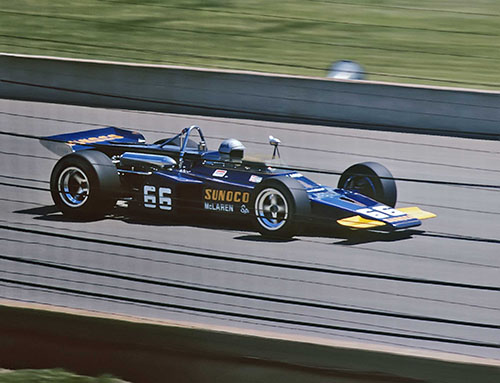
'Uncle Franco' must have felt back at a Formula One event when looking at the car that was the chassis revolution of 1971. The new McLaren M16 was heavily inspired by the Lotus 72 GP car. It was a sign of things to come. The M16 was designed around the tall, narrow Offy. At first sight a V8 might perhaps still work too (the 72 used a Cosworth, remember) but the Quadcam Ford/Foyt had some lay-out handicaps to deal with. Could a flat turbocharged V12 work in a car like this? Airflow out of the radiators would be blocked by the engine, inlet manifolds above the block would be in the airstream. In the hands of Mark Donohue, this Penske-entered car was the fastest thing on track in practice, yet missed out on pole after all. (photo copyright First Turn Productions LLC, used with permission)
And with all of this thinking about the engine package that was to be squeezed into a car, we haven't yet talked about using a single or two turbochargers, one for each bank of cylinders. The Ford V8, at that time maintained by AJ Foyt, used a single turbo. That caused difficulties in supplying all cylinders with an equal amount of air. Twin-turbos were not forbidden, by the way, at least not at the time. There had been a twin-turbocharged V8 in the 1973 Indy 500, with Smokey Yunick creating a Chevy stock block with two turbos. This car made the race even though it didn't get very far. But it's mentioned here to make clear that using two turbos on an engine with two cylinder rows wasn't a Can-Am Porsche exclusive. In fact, using two turbochargers on the Can Am 917 enhanced the logistics of fitting the entire package in the car. But doing something similar with an open-wheeler?
If turbocharging a flat engine was far from ideal with respect to logistics, using a V12 could have been another option. But it appears as if a genuine V12 was never considered by Ferrari. But imagine the thought about turbocharging a V12. In that case, would any of the older V12s used in F1 and sportscars have been suitable to start with? Remembering the primary opponent makes me rephrase that question into: did any of the existing Ferrari V12s have the potential to produce and withstand a 1000 and more hp? Somehow I doubt whether any of the sixties V12s (which had their roots in the fifties) was capable of that.
Another engine that could have been considered was the Dino V6 we mentioned earlier. With 2.4 litres it was close to the maximum of 2.65 litre. Four-valve cylinderheads could have been developed, since they in fact were later on and used on the competition versions of the Lancia Stratos once that car was finally homologated. But it's incredibly doubtful if this block with its production-based origins was capable of producing more than a 1000hp just to be on par with the Offy.
If Ferrari had taken up the Indy plans seriously, it seems it had little to fall back on for a start. The best engine option would likely have been an all-new design. In case inspiration would come from an elderly existing engine, it was to be heavily modified. Apart from high boost, the Ferrari Indycar engine would also have to withstand methanol fuel instead of gasoline. An obligation that required certain details about the engine specifications, the choice of material used for the cylinder head in particular.
The FerrariStory article suggests that the engine configuration of choice would have been the flat-twelve. However, the article gives more detail of the work that was carried out. Even though the lack of actual experience with turbocharging at Ferrari was already mentioned some work in this field was done. FerrariStory talks about Rocchi opting for a turbocharged engine despite the throttle-lag handicap of such engines. So Rocchi came up with the idea to include a small so-called combustor in the exhaust system. Once the driver lifted the accelerator the combustor would burn off fuel in order to keep the turbocharger spinning and providing boost to the engine. Work on this device appears to have been done. Although it was never seen on a Ferrari Indycar engine, could it perhaps have inspired the fuel-burning device said to be used on Ferrari's first turbocharged F1 cars, the 1981 126CK, also with the aim of reducing throttle lag?
And until now we've only been talking about the engine!
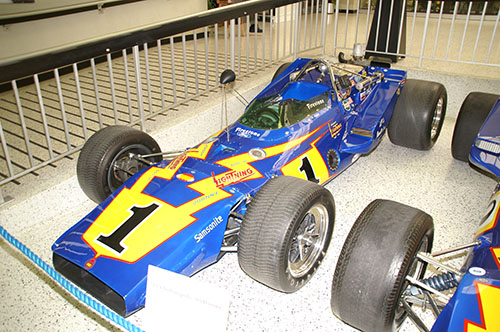
Al Unser's winning 1971 car was typically representative of how the average Indycar looked like in 1971. A car like this might have accommodated a (twin-)turbocharged boxer. (photo HG)
Another question rising when thinking of a 1973 Ferrari Indycar project is of course: would Ferrari have built its own chassis as well? Or would they have merely supplied engines and buy race-ready chassis from one of the usual Indycar constructors? If so, who would they have turned to?
In the early seventies, several chassis builders were active in the world of Indycars, but most of these built cars for a single team or team owner. Probably the only constructor selling cars to customers was Dan Gurney's All American Racers which built and sold the Eagle. The Eagle of the day, the Mk7, was indeed built to be versatile enough to accept different types of engines. The Offy-powered versions were fastest and most common but there were other examples with the Ford/Foyt V8. The aforementioned twin-turbo Chevy stockblock of Smokey Yunick was also fitted into such an Eagle. In other words: Dan Gurney could have been a candidate for supplying the chassis.
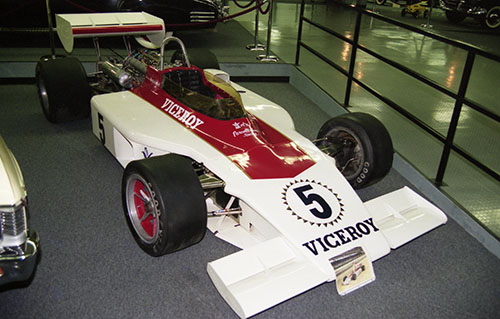
The Eagle Mk7 made its racing debut in 1972. Then as well as in 1973 it carried a much wider rear wing. It was built in fairly large numbers and generally available as a good, fast and suitable tool. The majority (like this one) was Offy-powered but it was possible to fit other engines. (photo HG)
With respect to using an Eagle chassis, the question remains whether the Eagle had to be modified to accept a 'TurboBoxer'. The length of both the Offy as well as that of the Ford/Foyt Quadcam was considerable but how long was the Boxer compared to those? If the Boxer had been longer, what modifications would have been needed to make the car comply to rules regarding maximum length, wheelbase, rear overhang and so on?
The mid-seventies at Indy became known as the McLaren-Eagle Era: between 1972 and 1976 the '500' (or whatever duration the race had due to rain-induced shortages) was won by either McLarens or Eagles, all of them using turbo Offy power. McLaren however didn't build customer cars as Eagle did. The only McLaren customer McLaren who also received the latest specification of their M16 was Roger Penske. But the factory team as well as Team Penske consequently sold off older cars that were replaced by fresh ones. That's how a number of M16s other than the factory cars and the Penske entries became active.
Interestingly: Penske competed in Can-Am, as did McLaren. From 1972 on, however, Penske pretty much became the Porsche factory team and went on to give the McLaren factory team a dose of their own medicine by dominating in a way with which Can-Am was familiar from the McLaren days. This hadn't stopped McLaren from supplying Penske with their latest versions of the M16 (the M16C) for 1973. So McLaren was at least willing to supply their lone customer with the latest machinery. If Ferrari had approached McLaren for a chassis supply, who knows what might have happened? But apart from the fact that the M16 was designed around the Offy how likely is it that Ferrari would have turned to an opponent they faced in Formula One?
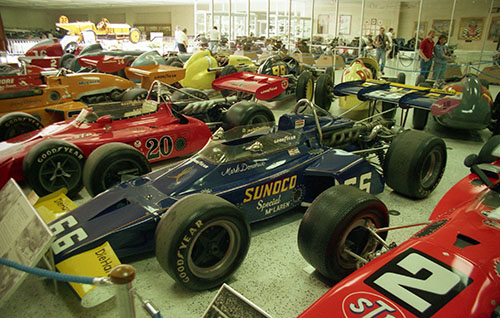
The 1972 race-winning Penske-entered McLaren-Offy M16B. Reducing frontal area and creating a free-standing rear engine with as less obstructions as possible became the norm. Somehow I find it difficult to envision an easy installation for a turbocharged Boxer in a car like this. (photo HG)
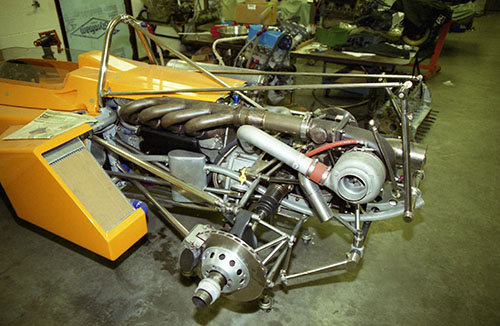
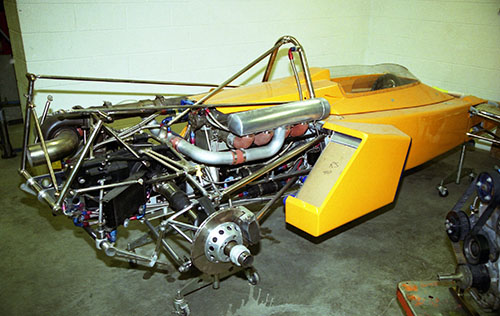
Photographed in November 2003 at an undisclosed place, one of the 1972 factory M16Bs in the process of being restored to its original configuration. The M16 had been a trendsetter in 1971 and in updated specifications was to remain a formidable contender up until 1976. As the Eagle Mk7 proved, the concept of the M16 wasn't obligatory to be competitive at Indy. A blessing for Ferrari since, as these photos suggest, it would have been difficult to use a M16-like chassis concept with a turbocharged 'boxer'. (photo HG)
Which leaves the constructors of either one-off cars or a very limited number of cars, such as Grant King. However, none of those had a big reputation at Indy and would have been a risk to deal with.
If Mario Andretti was included in Ferrari's plans the situation becomes even more interesting. In 1971 Mario was driving for the STP Granatelli Racing Team, using Ford-powered McNamara chassis built in Europe. Could this have been a new opportunity for Ferrari and the Granatelli brothers to cooperate?
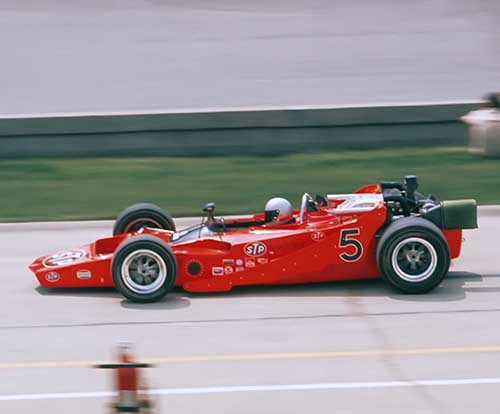
Mario Andretti's 1971 Indycar was this McNamara-Ford. If Ferrari had indeed pursued its Indy project, included Andretti in the program and looked for a suitable partner to supply engines to, would the STP-sponsored Granatelli team have been a suitable option? It's certain that a high-shouldered car like the McNamara could have accommodated the turbocharged flat-12 that Ferrari had in mind. (photo copyright First Turn Productions LLC, used with permission)
By the way, Mario changed teams for 1972 and became member of the Vel's Parnelli Jones superteam. The STP-sponsored Granatelli team ditched the McNamaras for new Lolas but remained with the bulky Ford V8 engines. In 1973 STP stopped sponsoring a Granatelli-maintained team, moving their sponsorship money to Pat Patrick Racing.
So we come to the last option and a very traditional one for Ferrari: designing a chassis of their own. This had of course the benefit of being able to design the car around the engine as a fully integrated part, eliminating any compromises on either the chassis or engine side. However, this would have required the specialist knowledge of designers and engineers familiar with Indy. Furthermore, chassis building hadn't been Ferrari's strong point in F1 in recent years. In fact, in 1973 they went as far as ordering British-manufactured monocoques to build their 1973 312B3 around. The same tubs were also used for the 1974 cars. Would allowing another company to build a Ferrari-designed monocoque have been necessary for the 1973 Indycar as well?
Whatever the chassis they would have used eventually, there was another important issue to consider. There had been a major rule change effective from 1972 on. In 1971 the McLaren M16 had put its rear wing onto what was called an engine cover since free-standing rear wings were forbidden. For 1972, however, the rules regarding wings were relaxed and free-standing, gearbox-mounted rear wings were permitted. Have another look at the pictures of the 1971 and 1972 McLaren to see how McLaren used the rules in these years. The permitted size of these wings was quite wide, and instantly the looks of the cars changed quite dramatically. Instead of high and wide at rear-wheel level, the cars became lower and narrower above the axle height in order to optimize the airflow towards the rear wing. Cars that were wide above that axle height were at a disadvantage and disappeared rapidly. This trend was, at least at first sight, definitely no good for the intended Ferrari 'TurboBoxer'. That engine was destined to have the inlet manifolds far away from each other, sticking up above that axle height. Could it have been possible to have the manifolds close enough to the engine's center to hide them behind the cockpit and/or the shoulders of the driver? Or were they destined to stick up into the airstream, thus reducing rear-wing efficiency as well as increasing drag?
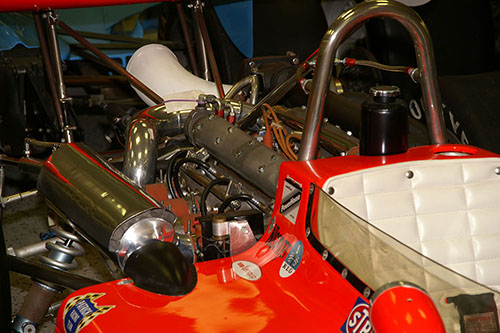
The inlet manifold on the Offy was not always close to and bent around the cylinder head as is proven by this picture of an STP Patrick Racing Team car. (photo HG)
To get an idea of how seriously the manifold problem could be taken, have another look at the inlet manifold on the second-place winner at the top of this page and in the picture below. This is the engine configuration as used on the winning car. Both were Eagle-Offies. Some chief mechanics chose to have the inlet manifold stick in the airflow to benefit from the cooling effects. George Bignotti with the Patrick Team preferred that option on his cars. But as the picture of the Sugaripe Prune car above proves, it was also possible to tuck the manifold away in the cockpit and driver profile for streamlining purposes. From 1973 on this setup became standard on the M16s built from that moment on. In general the Eagles used a setup like the one below.
In later years the Eagle Mk7's suitability with a lengthy twelve was proven, although the seriousness of the effort may be questioned. Besides that, the engine in question was not a flat-12 but a V12. Bob Olmstead was a car restorer, specializing on the Lincoln V12 Zephyr. To promote his activities with this V12 he had obtained the Voelker V12 engine, a 4.5-litre engine used in a car races in the 1938 (yes, I repeat 1938!) Indy 500. The engine was entered in following 500s up until 1949 but it never made the race again. Olmstead managed to reduce the size of the engine to the 2.65-litre limit (quite an achievement in itself) and fitted it with a turbocharger. He entered the engine fitted in an (1972) Antares chassis for the first time in 1977 but the car never ran a lap. From 1978 to 1981 Olmstead entered a 1973-built Eagle fitted with the Voelker V12. That car became known as the Screaming Eagle as well as for the fact that it rarely left Gasoline Alley for a lap. Somewhere on the Internet, I have spotted a picture of the car in the Indy pitlane. One of the Hungness yearbooks of the era mentioned the excitement when Olmstead had the V12 fired up in Gasoline Alley one day. Olmstead has been praised all over as a nice fellow but how serious could his Screaming Eagle be taken?
Another fact worth mentioning is that in the years from 1972 on several teams with McLarens and Eagles experimented with wheelbase lengths and overhangs of both front and rear ends in an attempt to find the best balance. This as well as the fact that eventually a twelve-cylinder Eagle came into existence would support the theory that a problem of engine length could be overcome, be it with an Eagle or another chassis suitable for installing a wide, flat twelve-cylinder Ferrari engine.
It must be obvious by now: turning plans to go to Indy in 1973 (or shortly thereafter) into reality would have caused quite a number of discussions and required a gigantic effort. It's that conclusion that leads to the following thoughts.
This entire 1973 Indy plan may be cause for many questions, especially for those who are familiar with Ferrari history as it did take place for everyone to see. The plans were made in 1971 but little could the people at Ferrari know about the situation the proud Italian team was to be in by 1973, the anticipated year of Ferrari's Indycar debut.
Ferrari had a much troubled F1 season in 1972 with their 312B2. Some of these problems were related to the Firestone tyres the team used. Chief designer Mauro Forghieri designed a new car according to new theories but the infamous 312B3 'Spazzaneve' was rejected and Forghieri was removed from the racing team.
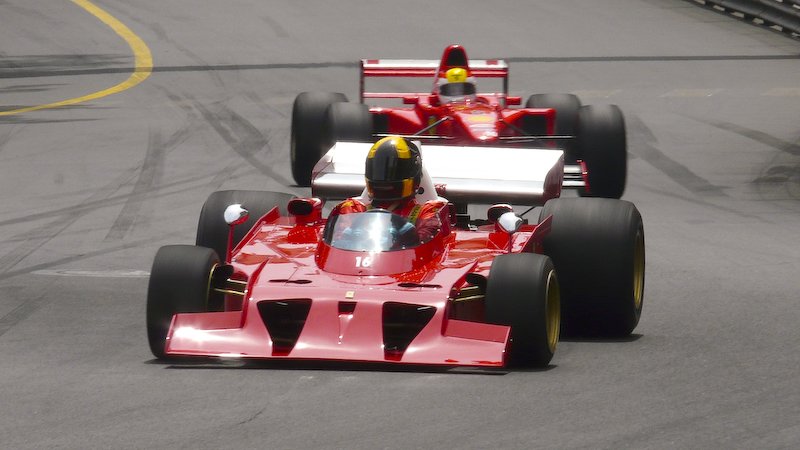
Nowadays in private hands, the 'Spazzaneve' was an ungainly, ugly car that makes the often bullied 312T4 look like a princess. It is said to have not been given a fair chance in late 1972. The basic concept of the car, however, would prove itself only a few years later when applied on later Ferraris. (photo 8W)
After the race at Monza team manager Peter Schetty was given the suggestion to have new monocoques built in England. Firestone engineer Bruce Harre recommended a friend of him in England for the job which resulted in the Jonathan Thompson-built monocoques already mentioned. The cars built around these monocoques threw Ferrari way back during the 1973 season. But in a 1972 season that was pretty mediocre for the F1 team, at least the sportscars yielded stunning successes. But not so in 1973.
While the year before the sportscar team had been invincible, in 1973 the 312PBs faced stiff opposition from the French Matra team. In fact, if Ferrari hadn't been helped by a decent score by a Daytona GT car in the Daytona 24 Hours, yielding Ferrari valuable additional points for the constructors title, the title battle would have been lost even earlier than eventually did happen.
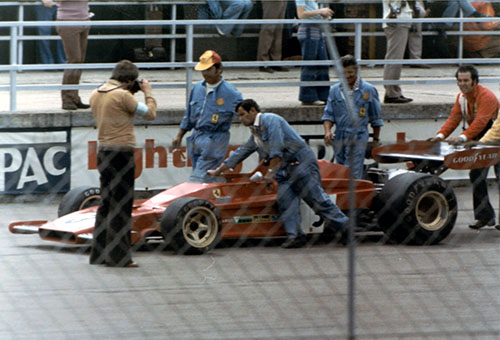
The first version of the 1973 312B3 looked much different from the preceeding 312B and 312B2 models. By the way, it wasn't ready to start the season and replaced the B2s that were pressed into some more duty for the first three races of the season. (photo copyright Rich Harman, used with permission)
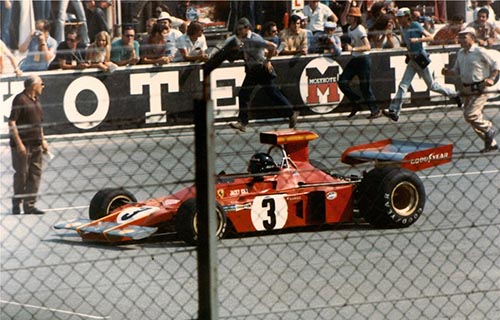
The 312B3 was modified during the season and the second version looked different. Unusual detail on the car was that on the other side an airscoop like the one in front of the left rear wheel was missing. The modifying process of the car was perhaps inspired by the dramatic results: the B2s had taken 4th place in all of their three starts, scoring 3 points in each race, the B3 scored 3 points during the entire season! (photo copyright Rich Harman, used with permission)
So on both fronts in which Ferrari traditionally participated it had difficulties to cope with. Would taking up another massive challenge (and the distraction that would have brought) have done the plagued F1 and sportscar teams any good? Would they really have dared compromising their participation in the primary categories of motor racing by taking up an entirely new category in which they had to almost start from scratch?
In fact, Ferrari did the opposite. But at a price.
Since Ferrari didn't start an Indy project at all (whatever state the plan had reached apart from the toe in the water with engineer Franco Rocchi) nothing in fact happened. Instead of creating more diversion by participating in even more formulae Ferrari decided to focus on F1 from 1974 on. This meant sacrificing the sportscar program that had always been such an important arena of competition for the company, and in which it had gained so much success. It must have been to swallow for the many Ferrari fans who also loved their team because of the sportscars. But the sacrifice wasn't in vain.
The F1 team was reorganized, Mauro Forghieri was called back to become technical director again and Luca di Montezemolo led the team from then on. As drivers they hired young and promising Niki Lauda and former Ferrari driver Clay Reggazoni, both coming over from BRM in 1973. Forghieri designed a new car arond the year-old Thompson monocoques but the cars retained the type designation 312B3. Now there must have been Ferrari fans who had their doubts about the wisdom of retaining the Thompson monocoques after the disastrous 1973 season. But they were proved wrong. The Ferrari F1 team team had a major revival, not in the least because of the qualities in their monocoques that Forghieri managed to extract, and the team got close to winning the titles in 1974.
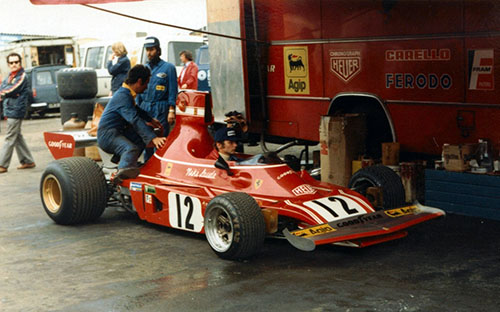
This is what the 1974 version of the cars built around the Thompson monocoques looked like. Because of their second year of duty none of the 312B3s survive in 1973 trim. Since the 1974 cars started the Ferrari renaissance of the seventies they deserve to be in the trim that made them famous for good reasons.
(photo copyright Rich Harman, used with permission)
So no Ferrari at Indy in the seventies. But Ferrari fans worldwide were treated to some great years, with three driver titles and four constructor titles between '75 and '79. At Le Mans and other sportscar races, however, competitive Ferraris were dearly missed.
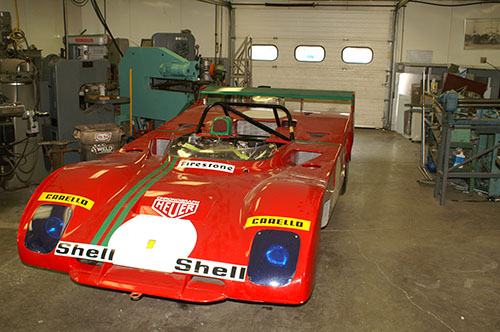
The true victims of the major reorganisations at Scuderia Ferrari starting late 1973 were the sportscars. Ferrari withdrew the lovely 312PBs from competition, limiting Ferrari's participation in endurance racing to supplying engines to Lancia's 1983-'86 LC2 programme and the WSC 333SP programme of the late nineties. Despite being named a Ferrari, the 333SP never ran as a factory-supported car, leaving the 312PB as the last factory-supported and factory-entered Ferrari endurance cars. (photo HG)
Is all of the above related to 'uncle Franco's visit' a lot of words but all of them about actually nothing? I wish that based on what I have been able to work out on this 1973 plan I could speak with anyone who was at Ferrari at the time, knew about the plan and was somehow involved. I am very curious what they would have to say to the findings and conclusions I presented here.
